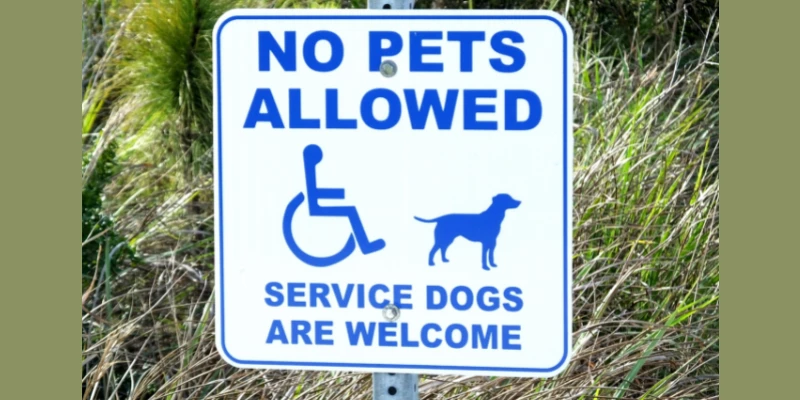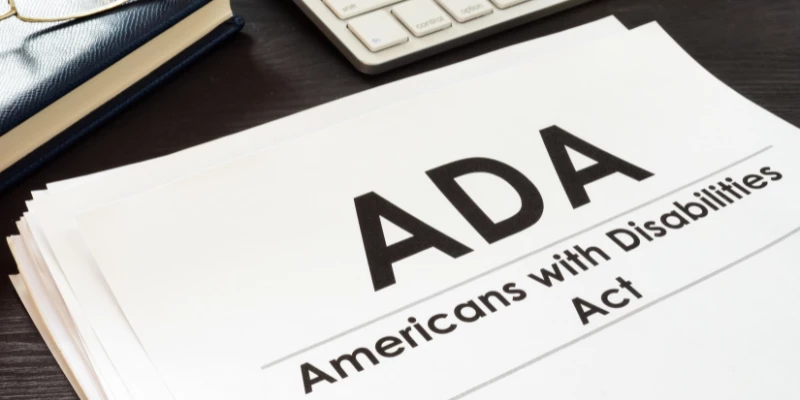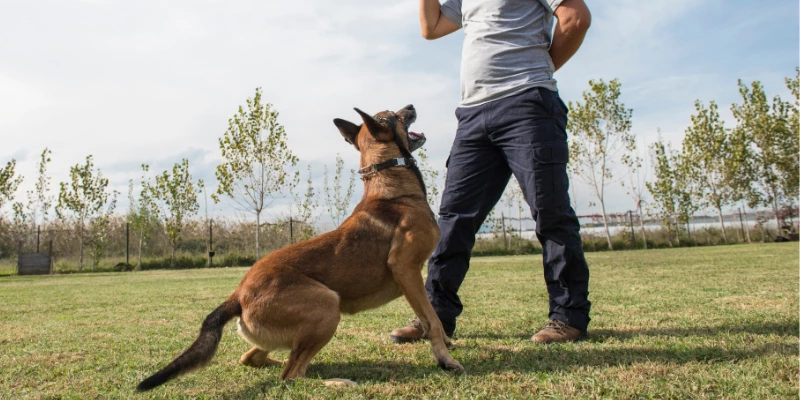First, I’d like to say that I know some people will disagree with some of these tips on how to spot a fake service dog.
So, the first thing that I am going to do is define what a “service animal” is as defined by the ADA from the U.S. Department of Justice.
I would like to point out that this article does not cover other countries’ policies on service dogs, so this article is just about what service dogs are defined as in the United States.
Also, don’t confuse a therapy or emotional support dog for a service dog since they are in separate categories and don’t have the same policy as service dogs.
You can learn more about the different types of dogs here: The difference between emotional support, therapy, and service dogs.
What is a Service Animal?
The Americans with Disabilities Act (ADA) defines a service animal specifically as an animal that has been trained to perform specific tasks or to do work in relation to its handler’s disability.
As of right now, dogs are the main service animal type listed by the ADA, but in some instances, a miniature horse may be used.

The ADA is the “Americans with Disabilities Act” that defines what a service animal is, what right disabled people with service dogs have, and where these animals are allowed access.
The ADA requires all service animals to be trained. Not only do service dogs need to be trained to perform tasks or work, but they also need obedience training to be well-behaved in public.
Most people understand that service dogs need training for tasks but some may not be aware that dogs need training for obedience as well.
To be classified as a true service dog, the dog needs both types of training.
Otherwise, the dog is categorized as a fake service dog.
I am going to go over the requirements in more detail and then list the 12 tips to spot a fake service dog.
Service Dog Certification
There is no formal service dog certification. Service dogs require no paperwork to be trained and used as service animals.
You don’t even have to get formal training and can train your animal yourself, but it is recommended to get formal training to ensure your animal can correctly be classified as a service animal.
Service dogs (under ADA requirements) are dogs that have been “trained to perform tasks or do work related to their handler’s disability“.
Service dogs (under ADA requirements) are expected to be trained to be well-behaved in public and not cause any disruption.
While all of this falls under the ADA requirements, there is no certification or paperwork required to have a service animal.
While there is no certification or proper training required for your dog to become a service dog, you can’t just slap a vest on your pet and call it a service dog.
That is why I wanted to explain all the requirements under the ADA before I get into how to spot a fake service dog or poorly trained service dog (which would also be considered a fake service dog).
ADA Requirements for Service Animals
Before I get into the 12 tips to spot a fake service dog, let me reiterate something.
If a dog doesn’t have training (either by a professional or trained properly by their handler) to perform tasks or to do work based on a disability and doesn’t have obedience and behavior training for public settings, it “IS NOT” considered a legitimate service dog under the ADA requirements.

If a dog doesn’t have the proper training to help with a disability and to maintain itself in public without disruption, it “IS NOT” considered a true service dog and most people will see it as a fake service dog.
Without those requirements, a dog should be considered a fake service dog.
I get that training can be ridiculously expensive but it is a necessity for the dog to be classified as a service dog.
I must mention that not only should your dog have proper training, but other requirements need to be considered, including:
- Service dogs should be old enough to train, around a year old for most breeds, and needs to receive around 6 months of proper training
- Service dogs should be physically and mentally capable of performing the tasks or work needed for the disability of their handler
- Service dogs should be current on vaccinations
- Service dogs should be in good health with no issues (such as kidney problems that cause them to potty uncontrollably)
- Service dogs should not be in service for longer than 10 years
ADA Service Animal Requirements for Public Establishments
Per ADA requirements, public establishments that provide access to service dogs are only allowed to ask 2 questions when it isn’t obvious what service the animal is providing to their handler.
The first question is “Is the dog a service animal that is required because of a disability you have?“.
The second question is “What tasks or work has the dog been trained to perform concerning your disability?“.
Establishments are not allowed to ask what disability the handler has or any other questions about their disability.
They can’t ask for documentation, certification, or any other paperwork.
They can’t even ask the handler to demonstrate what services the dog performs concerning the disability.
They are ONLY supposed to ask these 2 questions I mentioned above.
However, it is the establishment’s right to deny access to the handler and the service dog or ask the handler to leave if the dog is disruptive and the handler can’t get control of the dog.
Establishments also have the right to deny access or ask the handler to leave if the dog is not housebroken. Establishments are not expected or required to provide care for or supervise a service animal.
There are many misinformed people in this world and I’m sure some of them will have disagreements with parts of this article, but my research is accurate.
If you have any doubt, here is the link to the ADA requirements for service animals.
Now that I’ve gotten all that out of the way, let’s take a look at how to spot a fake service dog.
12 Tips to Spot a Fake Service Dog
Please refer to the ADA policy that I mentioned above, which states that a service dog “must” be trained not only for the tasks or work to be performed concerning their handler’s disability but also to be well-behaved and non-disruptive in public settings.
Let me be as clear as possible before I start with how to spot a fake service dog. If a service dog is in a public setting, it is working.
I’ve read comments in other places where people will state, “well, my dog wasn’t working and that is why they thought it was a fake service dog”.
If the dog is in public and it is a service dog…it is considered to be working at all times.
What I mean by this is even if the handler is relaxing and the dog isn’t doing anything concerning the handler’s disability at that moment, it is still considered to be working because it is still expected to maintain well-behaved behavior and not be disruptive while in public.

1. Service Dogs Require Potty Training
All service dogs are required to be potty trained and should not go indoors unexpectedly. If you see a dog potty unexpectedly, it is likely a fake service dog.
If you consider your dog a service dog that has the proper training and shouldn’t be pottying in public, but your dog can’t seem to control its bladder, then it is time to retire your dog.
Service dogs should only go potty on command by their handler.
The ADA requires all service animals to be in good health, which includes any issues they may have with their kidneys or other issues that may cause them to potty unexpectedly.
Any animal that is reaching or in its old age period needs to be retired per ADA requirements.
The ADA states that no animal should be in service for more than 10 years. So if a dog started to be a service animal at 2 years old, it would need to be retired at 12 years old.
2. Service Dogs Should Not Be Aggressive
Service dogs should not have aggressive behavior at all, period. I don’t know how much more I can say about that. Dogs with aggressive behavior that can’t be controlled should never even be considered as an option for a service dog.
When I say aggressive behavior, I mean a dog that lunges out at other animals or people, growls or aggressively shows its teeth, and bites other animals or people, among other types of aggression.
If a dog is being aggressive in public, it is almost certainly a fake service dog. The only exception I can think of in this situation is if the dog is trying to protect its handler that is in danger.
However, that wouldn’t be aggressive behavior, but rather defensive behavior.
3. Service Dogs Should Not Seek Attention
If a dog is going up to other people and seeking attention, it is likely a fake service dog. Dogs that are working are trained and shouldn’t seek out attention from strangers while they are working.
Some people may say, well my dog wasn’t working at the time it was seeking attention. I will reiterate this again if a dog is in a public setting, it is working at all times in that public setting.
That is what classifies it as a service dog.
If you see a dog that is running around and trying to get the attention of others, it is a fake service dog. In the title of this article, I mentioned poorly trained dogs.
To me, that means if a dog is poorly trained, it is the same thing as a fake service dog.
Service dogs have to be thoroughly trained and well-behaved to be considered service dogs. Otherwise, they are nothing more than fake service dogs, whether the handler intends it to be that way or not.
4. Service Dogs Should Not Bark Continuously
If a dog is continuously barking in a public setting and the handler has not gotten control of it, the dog is likely a fake service dog.
Service dogs are trained to be well-behaved in public, which will include obedience and behavior training. A barking dog is an indicator that the dog hasn’t been trained properly.
The only exception to this is if the service dog is trying to alert the handler or get the attention of nearby people in case of an emergency.
In some cases, service dogs will be trained to bark to alert, but the bark should be in a non-aggressive manner that falls in line with the training the dog received to become a service dog.
5. Service Dogs Should Not Be Carried or in a Cart
Ever seen a small dog being pushed around in a cart? I have and they just scream of fake service dog or pet to me.
This one is debatable to a certain extent. Some people state they need to carry their dog or need their service dog close to them to ensure their dog will sense when there is a change in their body smell.
These types of service dogs are called alert dogs and are usually alert for diabetes and other conditions.
That is why the dog is being carried or pushed in the cart.
However, this is debatable because dogs have such a better sense of smell than we do, so they should be able to sense any smell change in their handler’s body when they are on the floor or ground and don’t need to be carried or pushed in a cart to sense that smell change.
6. Service Dogs Should Not Be Excessively Sniffing
If a dog is going up to everything and sniffing a lot, it is likely a fake service dog.
I know that I keep beating this over the head, but service dogs should be trained not only to service their handler but also to be well-behaved.
A dog going around and sniffing everything is not a well-behaved animal. Service dogs should follow the requirements put out by the ADA.
So if a dog is sniffing everything, it is a fake service dog.

7. Service Dogs Should Not Seek Out Food
This is a really good indicator of a fake service dog. Even pets should have the basic training to know not to just snatch food when there is an opportunity.
This is crucial to get a dog to understand the boundaries of what is allowed and what isn’t.
If the dog is considered a service dog, this is especially. No true service dog will go around and snatch food when there is an opportunity to do so.
Part of a service dog’s training would eliminate this type of behavior. So, if a dog is snatching food, it is a fake service dog.
8. Service Dogs Should Not Pull On a Leash
If you are out in a public setting where service dogs are allowed and you encounter a dog constantly pulling on its leash, it is likely a fake service dog.
Service dogs should not pull on a leash since they are supposed to be trained to remove this type of behavior.
If a dog is pulling on its leash, it can’t be a true service dog based on the ADA requirements for service dogs.
9. Service Dogs Should Not Exhibit Nervous Behavior
This is another debatable tip I’m sure. Some people will state that their dog just has nervous behavior.
I know my chihuahua exhibits this type of behavior all the time.
Then again, I would never try to consider my chihuahua, “Lily”, as a service dog either.
Service dogs should fall in line with the ADA requirements, which include the proper training to eliminate this type of behavior.
If dogs are exhibiting nervous behavior while out in public, how can they focus on the service they are supposed to be providing their handler?
10. Service Dogs Should Not Be Without a Leash
A dog without a leash can be an indication of a fake service dog. Like most cases, there are exceptions to this rule, so let me elaborate a little further.
If a leash impedes the service the dog is supposed to provide to its handler, then no leash is required for the service dog.
So, this one isn’t a dead giveaway for a fake service dog, but can be a good indication of one.
11. Service Dogs Should Not Be Too Young
I’ll be the first to admit that people can debate this one. The debatable question would be “How do you know how young a dog is?”.
I understand that age can be difficult to tell in some dogs, but if it is obvious that it is a puppy, then it is too young to be a service dog.
Service dogs are required to have proper training (which could take up to 6 months).
If a dog is obviously younger than 6 months, there is no conceivable way it could have the proper training required for a service dog.
12. Service Dogs Should Not Be Whining
The last one I will talk about is a dog that whines a lot. This goes hand in hand with the barking that I referred to earlier.
Some dogs are trained to bark or whine as a way to alert their handler or nearby people.
They are trained to bark or whine in an emergency situation to draw attention to them and their owner.
They can be trained to do this in case their handler needs assistance from other people while they are in a public setting.
However, when you observe a dog that is whining a lot and you can tell that its handler has no emergency, that is an indication of a fake service dog.

How to Train Your Dog to Be a Service Dog
Service dog training can get very expensive in a hurry when referring to professional training.
However, training is necessary to have a true service dog that should perform tasks concerning your disability and behave well in public.
We are affiliates for a dog training program that is a DIY program to help you train your dog on your time.
This dog training program will help eliminate bad behavior and create well-behaved, obedient dogs.
Most of the basic training your dog will need to become a service dog can be found in this training program.
If you have the patience and time to train your dog, you could potentially save thousands of dollars.
Click here to view the dog training program & save money with a DIY dog training system guaranteed to work!
(One-time payment of $47.00 & 60-day money-back guarantee)
If you don’t have the time or patience to train your own dog, you can try to find a dog training professional in your local area.
You can also check with your local state and government to see if there are any available programs to help with the cost or to help with assistance in getting a service animal.
Recap
Thank you for sticking around and reading my entire article on tips to spot a fake service dog.
I hope that you were able to learn the differences between a real service dog and a fake service dog today.
I know that some of the tips will be controversial for some people.
So I say to them, read the ADA requirements for establishing a service dog as this is the official document that determines what is a real service dog versus a fake service dog.
This article isn’t meant to stir any controversy and to claim your dog is a fake service dog, I just state the requirements under the ADA and what they expect of a service dog.
If a dog does not meet these requirements and is brought into a setting where only service animals are allowed, it is considered a fake service dog.
Other Articles About Service Dogs
- Are Dogs Allowed in Walmart? Home Depot? 40 Pet-Friendly Stores
- What are Service Dogs? Detailed Guide with 11 Types & More
- How to Train or Register Your Dog to Be a Service Dog
- Differences Between Service Dog, Emotional Support Animal, & Therapy Dog
References





